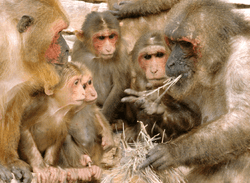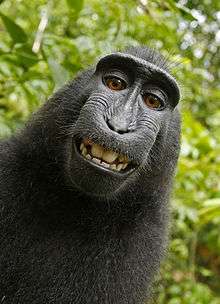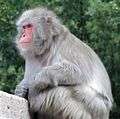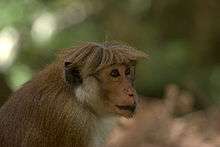Macaque
| Macaques[1] | |
|---|---|
_Photograph_By_Shantanu_Kuveskar.jpg) | |
| Bonnet macaque | |
| Scientific classification | |
| Kingdom: | Animalia |
| Phylum: | Chordata |
| Class: | Mammalia |
| Order: | Primates |
| Family: | Cercopithecidae |
| Subfamily: | Cercopithecinae |
| Tribe: | Papionini |
| Genus: | Macaca Lacépède, 1799 |
| Type species | |
| Simia inuus Linnaeus, 1766 | |
| Species | |
|
See text | |
The macaques (/məˈkɑːk/ or /məˈkæk/[2]) constitute a genus (Macaca) of Old World monkeys of the subfamily Cercopithecinae. The 23 species of macaques are widespread over Earth. Macaques are principally frugivorous, although their diet also includes seeds, leaves, flowers, and tree bark, and some, such as the crab-eating macaque, persist on a diet of invertebrates and occasionally small vertebrates. All macaques' social groups are arranged around dominant, matriarchal females.[3]
Description
Aside from humans (genus Homo), the macaques are the most widespread primate genus, ranging from Japan to the Indian subcontinent, and in the case of the barbary macaque (Macaca sylvanus), to North Africa and Southern Europe. Twenty-three macaque species are currently recognized, including some of the monkeys best known to nonzoologists, such as the rhesus macaque (M. mulatta), and the barbary macaque, a colony of which lives on the Rock of Gibraltar. Although several species lack tails and their common names refer to them as apes, these are true monkeys, with no greater relationship to the true apes than any other Old World monkeys.
In some species, skin folds join the second through fifth toes, almost reaching the first metatarsal joint.[4]
Social behavior

Macaques have a very intricate social structure and hierarchy. If a macaque of a lower level in the social chain has eaten berries and none are left for a higher-level macaque, then the one higher in status can, within this social organization, remove the berries from the other monkey's mouth.[6]
Relation with humans
Several species of macaques are used extensively in animal testing, particularly in the neuroscience of visual perception and the visual system.
Nearly all (73–100%) pet and captive rhesus macaques are carriers of the herpes B virus. This virus is harmless to macaques, but infections of humans, while rare, are potentially fatal, a risk that makes macaques unsuitable as pets.[7]
Urban performing macaques also carried simian foamy virus, suggesting they could be involved in the species-to-species jump of similar retroviruses to humans.[8]
The people of Vietnam continue to engage in the hunting, killing, and eating of macaques.
Species
Genus Macaca
- M. sylvanus group
- Barbary macaque, M. sylvanus
- M. nemestrina group
- Lion-tailed macaque, M. silenus
- Southern pig-tailed macaque or beruk, M. nemestrina
- Northern pig-tailed macaque, M. leonina
- Pagai Island macaque, M. pagensis
- Siberut macaque, M. siberu
- Moor macaque, M. maura
- Booted macaque, M. ochreata
- Tonkean macaque, M. tonkeana
- Heck's macaque, M. hecki
- Gorontalo macaque, Macaca nigrescens
- Celebes crested macaque, M. nigra
- M. fascicularis group
- Crab-eating macaque, M. fascicularis (also known as the long-tailed macaque)
- Stump-tailed macaque, M. arctoides
- M. mulatta group
- Rhesus macaque, M. mulatta
- Formosan rock macaque, M. cyclopis
- Japanese macaque, M. fuscata
- M. sinica group
- Toque macaque, M. sinica
- Bonnet macaque, M. radiata
- Assam macaque, M. assamensis
- Tibetan macaque, M. thibetana
- Arunachal macaque, M. munzala
- White-cheeked macaque, M. leucogenys[9]
Prehistoric (fossil) species:
- Macaca anderssoni Schlosser, 1924
- M. jiangchuanensis Pan et al., 1992[10]
- M. libyca Stromer, 1920
- M. majori Schaub & Azzaroli in Comaschi Caria, 1969 (sometimes included in M. sylvanus)
Gallery
 Stump-tailed macaque (M. arctoides)
Stump-tailed macaque (M. arctoides) Japanese macaque (M. fuscata)
Japanese macaque (M. fuscata) Pig-tailed macaque (M. nemestrina)
Pig-tailed macaque (M. nemestrina).jpg) Sulawesi's black macaque (M. nigra)
Sulawesi's black macaque (M. nigra) Self-portrait photograph of a crested black macaque (the "monkey selfie")
Self-portrait photograph of a crested black macaque (the "monkey selfie") Japanese macaque (M. fuscata)
Japanese macaque (M. fuscata) Japanese macaques (M. fuscata) in Sagano
Japanese macaques (M. fuscata) in Sagano Toque macaque (M. sinica) in Sri Lanka
Toque macaque (M. sinica) in Sri Lanka
See also
References
- ↑ Groves, C.P. (2005). Wilson, D.E.; Reeder, D.M., eds. Mammal Species of the World: A Taxonomic and Geographic Reference (3rd ed.). Baltimore: Johns Hopkins University Press. pp. 161–165. OCLC 62265494. ISBN 0-801-88221-4.
- ↑ macaque pronunciation by Oxford Dictionaries
- ↑ John G. Fleagle (8 March 2013). Primate Adaptation and Evolution. Academic. p. 123. ISBN 978-0-12-378633-3.
- ↑ Ankel-Simons, Friderun (2000). "Hands and Feet". Primate anatomy: an introduction. Academic Press. p. 340. ISBN 0-12-058670-3.
- ↑ Boussaoud, D.; Tanné-Gariépy, J.; Wannier, T.; Rouiller, E. M. (2005). "Callosal connections of dorsal versus ventral premotor areas in the macaque monkey: A multiple retrograde tracing study". BMC Neuroscience. 6: 67. doi:10.1186/1471-2202-6-67. PMC 1314896
 . PMID 16309550.
. PMID 16309550. - ↑ "The Life of Mammals" Hosted by David Attenborough, 2003 British Broadcasting Corporation. BBC Video
- ↑ Ostrowski, Stephanie R.; et al. "B-virus from Pet Macaque Monkeys: an Emerging Threat in the United States?". Emerging Infectious Diseases. Centers for Disease Control and Prevention (CDC). 4 (1): 117–121. doi:10.3201/eid0401.980117. Retrieved January 2010. Check date values in:
|access-date=(help) - ↑ University of Toronto - News@UofT - Performing monkeys in Asia carry viruses that could jump species to humans (Dec 8/05) Archived March 22, 2006, at the Wayback Machine.
- ↑ Li, C.; Zhao, C.; Fan, P. (25 Mar 2015). "White-cheeked macaque (Macaca leucogenys): A new macaque species from Modog, southeastern Tibet". American Journal of Primatology. 77: 753–766. doi:10.1002/ajp.22394.
- ↑ Hartwig, Walter Carl (2002). The primate fossil record. Cambridge University Press. p. 273. ISBN 0-521-66315-6.
External links
| Wikimedia Commons has media related to Macaca. |
| Wikispecies has information related to: Macaque |